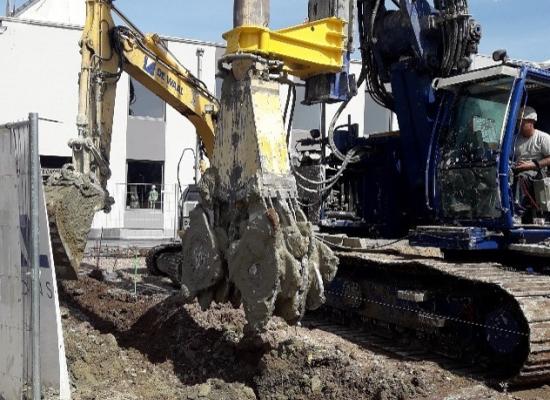History and location
The remediation site is located in a residential zone. In the 19th century, a gasworks operated on the premises. Based on old plans, there were two factories during that period. It is assumed that after the cessation of operations, the gasworks was demolished and the demolition debris was spread across the site (debris-containing fill layer).
The current Van Craesbeeckstraat is located between two apartment buildings spanning the former gasworks site. All residential blocks have basements with a depth of approximately 2 meters below ground level. At the time of the remediation works, the residential blocks on the site were vacant, awaiting a renovation project.
The residential blocks to the east of Van Craesbeeckstraat form a rectangular complex with a central courtyard accessible via Van Craesbeeckstraat through 2 entrance gates that create an underpass beneath the apartment building. A similar situation is found behind the residential blocks to the west of Van Craesbeeckstraat. On this western courtyard, before the start of the remediation works, there are 2 underground heating oil tanks that were previously taken out of service.
On the courtyard of the eastern residential block, there are 4 underground septic systems present. These are pits consisting of a bacterial bed and a septic tank, each with dimensions of approximately 10 m x 2.8 m. Similarly, on the courtyard of the western residential block, 2 such septic systems are present.
Contaminations
At the site of the former gasworks located at Van Craesbeeckstraat / Kronenburgstraat / Willem Lepelstraat / Nationalestraat in Antwerp, the following contaminations were identified during the execution of soil investigations, requiring soil remediation:
-
Historical contamination with heavy metals, PAHs, and cyanides in the solid part of the soil and with cyanides in the groundwater linked to the fill layer.
-
Historical contamination with mineral oil, benzene, and PAHs in the solid part of the soil and with mineral oil and PAHs in the groundwater (contamination core I).
-
Historical contamination with benzene (and mineral oil) in the solid part of the soil (contamination core II).
-
Historical contamination with mineral oil and benzene in the solid part of the soil (contamination core III).
Description of Remediation works
Initially, the following preparatory works were carried out:
-
A comprehensive site description was conducted in agreement with all relevant parties.
-
Installation and measurement of settlement bolts.
-
Acquisition of plans for cables and pipes (KLIP).
-
Establishment of the construction site setup.
On-site activities commenced with the removal of all tile pavements, and the roof slab of the basement was supported at the passage towards the inner courtyard.
The soil remediation of the contaminated fill layer involved excavating 70 cm of the contaminated material and subsequently adding a 70 cm clean soil layer. This clean soil layer remediation took place in the front gardens on Willem Lepelstraat, the western inner courtyard, and the southern section of the eastern inner courtyard.
At the front garden of the residential block located on Willem Lepelstraat (plots 2462 F and 2462 G), an additional excavation of the fill layer down to 2.5 meters below ground level was performed. This was done in a phased manner both towards the building and towards the street.
The soil remediation of contamination core I, situated in the inner courtyard of the eastern residential block, involved excavating the contamination down to 6 meters below ground level, and locally up to 8 meters below ground level. Excavation measures included phased excavation and the use of shoring boxes as stabilizing techniques. Groundwater was locally lowered using deep wells to allow dry excavation. The pumped contaminated groundwater was discharged into the sewage system after treatment. The treatment process involved passing the contaminated groundwater through a wastewater treatment plant (GWZI) with a capacity of 10 cubic meters per hour.
Within the excavation boundary on the Fierensblokken courtyard, there was a purification system with "bacteriors" that needed removal after emptying and cleaning.
For contamination core II situated in the inner courtyard of the eastern residential block, soil remediation involved excavating the contamination down to 2.5 meters below ground level.
Contamination core III, located in the front garden of the residential blocks on Van Craesbeeckstraat (plots 2462 P and 2462 A2), will be addressed in a later phase and is not part of the current remediation works.
All contaminated soil was transported to a soil treatment center for physico-chemical or thermal soil treatment. A total of 6,150 tons were transported for processing. During excavation, the outline of the former gasworks' foundations was discovered and dismantled. Additionally, 53 tons of pure tar were encountered and disposed of at an authorized facility.
After the completion of soil remediation works, the site was cleaned up. As the site is part of a redevelopment project, no additional finishing was provided after backfilling works.










